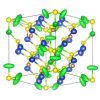Materials with Thermoelectric Properties group

Perspective view of the cubic unit cell of the Cu12Sb4S13 tetrahedrite in thermal ellipsoid representation (95% probability level). The atoms Cu1, Cu2, Sb and S are represented by dark blue, green, brown and yellow ellipsoids, respectively

HAADF-STEM image of single-crystalline (PbSe)5(Bi2Se3)3m taken along the zone axis 010. The crystal structure is overlaid in the image (Pb, Bi and Se are shown in green, pink and yellow, respectively). The bottom image shows the corresponding electron diffraction diagram

High-power-density single-couple thermoelectric generator
Last publications
- AsTe3: A novel crystalline semiconductor with ultralow thermal conductivity obtained by congruent crystallization from parent glass
J. B. Vaney, Cédric Morin, Julie Carreaud, Christophe Candolfi, Andrea Piarristeguy, Mickael Bigot, Judith Monnier, Annie Pradel, V. Nassif, Gabriel Cuello, Petr Levinsky, Bertrand Lenoir, Sylvian Cadars, Assil Bouzid, Olivier Masson, Jean-Paul Laval, Julie Cornette, Maggy Colas, Eric Alleno, Gaelle Delaizir
Journal of Alloys and Compounds, 2025, 1004, pp.175918. ⟨10.1016/j.jallcom.2024.175918⟩ - Oxidation Behavior and Integration into High Power Density Thermoelectric Generators of Commercial Half-Heusler Alloys
Soufiane El Oualid, Philippe Masschelein, Lionel Aranda, Ghouti Medjahdi, Benoît Denand, Arthur Wieder, Ilayda Terzi, Przemyslaw Blaschkewitz, Pawel Ziolkowski, Christophe Candolfi, Bertrand Lenoir
ACS Applied Materials & Interfaces, 2025, 17 (28), pp.40773-40787. ⟨10.1021/acsami.5c08992⟩ - TiO2-driven ZrO2 leads to the high thermoelectric performance of ZrNiSn half-Heusler alloy
Shamma Jain, Ajay Kumar Verma, Kishor Kumar Johari, Sudhir Kumar, Christophe Candolfi, Bertrand Lenoir, Bhasker Gahtori
Materials Research Bulletin, 2025, 187, pp.113369. ⟨10.1016/j.materresbull.2025.113369⟩
Presentation
Thermoelectric effects enable to convert elegantly either electricity into a temperature difference, thereby producing “cold” (Peltier effect), or any heat source into useful electricity (Seebeck effect). The studies carried out by the team address the challenges faced by this green technology :
- the identification and development of new thermoelectric materials with enhanced conversion performance compared to state-of-the-art thermoelectric materials,
- understanding the intrinsic mechanisms governing the electronic and thermal transport in thermoelectric materials,
- the search for innovative solutions for the manufacture and reliability of thermoelectric modules.
The team mainly focuses on degenerate, low-band-gap semiconductors, which are the materials of choice for thermoelectricity. The synthesis of these materials is carried out either in single crystalline or polycrystalline form by various synthesis techniques (Bridgman, flux-growth for single crystals, powder metallurgy for polycrystals).
Thanks to its unique experimental facilities, the team can probe the electrical, thermal and galvanomagnetic properties over a wide range of temperatures (2 - 1500 K). Research activities also rely on large-scale facilities (ILL, ESRF) to deepen the knowledge of the lattice dynamics and electronic properties of the materials synthesized.
Significant efforts are also devoted to the development of thermoelectric modules, on-going from the modeling to the manufacturing through the optimization of their reliability.
Research topics
Synthesis and characterisation of conventional or advanced thermoelectric materials
The group works on several families of promising materials for power generation, such as, among others, chalogenides and Zintl phases:
- SnTe and Bi2Te2Se chalcogenides are two defined compounds that have the peculiarity to be dopableed by resonant impurities. This specificity opens interesting perspectives to advantageously modulate their electronic properties.
- In the case of Zintl phases, one of the main challenges is to discover efficient n-type materials. This study is carried out in collaboration (ANR PRCI) with the University of Koç in Istanbul, Turkey (Dr. Umut Aydemir's group).
The studies on conventional or advanced materials relies on the synthesis and thorough characterization of their electrical and thermal properties. In addition, they benefit from the support of ab-initio electronic structure calculations thanks to a long-standing collaboration with the University of Krakow in Poland (Pr. Janusz Tobola and Dr. Bartlomiej Wiendlocha's group).
Project:
ANR DENZIP 2019-2022
Thesis:
- Adèle LEON
- Oussama EL-HAMOULI
Articles:
- Band structure engineering in Sn1.03Te through an In-induced resonant level, Misra et al., J. Mat.Chem. C, 2020, 8, 977
- High temperature thermoelectric properties of the tetradymite Bi2-xPbxTe2Se (0 ≤ x ≤ 0.03), Léon et al., Applied Physics Letter, 2021, 119, 232103
Development of thermoelectric modules for applications in power generation
Although the thermoelectric technology presents many advantages (solid-state conversion, high reliability, …), several obstacles must be overcome to make it a viable option for power generation. In particular, the thermal and chemical stability of the materials and interfaces must be ensured under operating conditions. The team is addressing these issues in the frame of the ANR i-HEPHAISTOS, which aims to develop low-cost skutterudite-based modules for moderate temperature applications.
It is also involved in the development of high power density thermoelectric modules integrating advanced materials. This work is the subject of a maturation project (MOTHEL project).
The group is also involved in an ANR project (HYDRES) the objective of which is to design a device to recover the energy lost thermally in a photovoltaic solar cell by coupling to this cell a thermoelectric generator.
Projects:
- Maturation MOTHEL, 2020-2021
- ANR i-HEPHAISTOS, 2021-2024
- ANR HYDRES, 2022-2025
Post-doc:
- Soufiane EL-OUALID
Articles:
High power density thermoelectric generators with skutterudites, El-Oualid et al., Advanced Energy Materials, 2021, 2100580, Cover page
Know-how
Synthesis
- Growth of cm3-sized single crystals of semiconductors (IV-VI, V-V, V-VI, ...)
- Synthesis of polycrystalline thermoelectric materials
- Assembly of thermoelectric legs by the SPS technique
- Manufacturing of thermoelectric modules
Characterization
- Characterization of the electrical, thermal and galvanomagnetic properties of the synthesized materials over a wide range of temperatures (2 – 1500 K)
- Measurements of the electrical contact resistance
- Characterization of thermoelectric modules
Modeling
- Modeling using finite-element analysis applied to thermoelectric modules
Members
Professors, assistant professors
Technical and support staff
- Philippe MASSCHELEIN
Post-doctoral researchers
- Rana GHANNAM
PhD students
- Swagata PATRA
- Ilayda TERZI
- Arthur WIEDER
Publications
Contact
Head of the group
Bertrand LENOIR
bertrand.lenoir@univ-lorraine.fr
+33 (0) 3 72 74 26 53
Nancy-Artem
Institut Jean Lamour
Campus Artem
2 allée André Guinier - BP 50840
54011 NANCY Cedex
